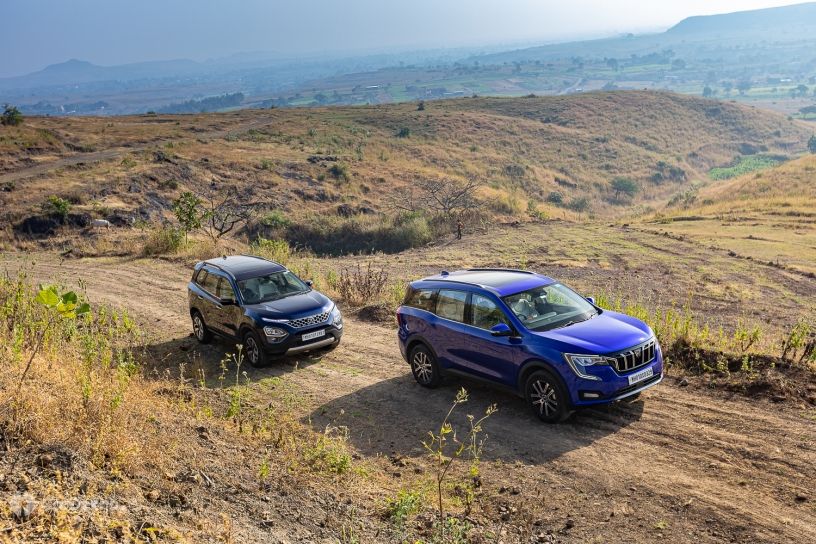Mahindra XUV700 Vs Tata Safari: Space Comparison
Published On Dec 25, 2021 10:00 AM By Tarun
- Write a comment
Which one is the roomier and more family-oriented three-row SUV? Let’s find out

With Mahindra launching the XUV700, the Tata Safari now has its toughest opponent in this space. Both are big SUVs with many premium features and powerful engines. While the Safari is offered in six and seven seater configurations, the XUV700 gets a choice of five and seven seats.
For those planning to buy a new three-row SUV and want the roomier of these two, here’s a detailed comparison of their interior space. An important thing to note is that we have compared the seven-seater XUV700 with the six-seater Safari.
Exterior dimensions
| Dimensions |
XUV700 |
Safari |
Difference |
| Length |
4695mm |
4661mm |
34mm (XUV700 is longer) |
| Width |
1890mm |
1894mm |
4mm (Safari is wider) |
| Height |
1755mm |
1786mm |
31mm (Safari is taller) |
| Wheelbase |
2750mm |
2741mm |
9mm (XUV700 has a longer wheelbase) |
The XUV700 is longer than the Safari as is its wheelbase, while the latter is taller. Tata’s offering is marginally wider too.
Front Row Space


| Dimensions |
XUV700 |
Safari |
| Legroom (Min-Max) |
910mm - 1065mm |
925mm - 1110mm |
| Kneerom (Min-Max) |
570mm - 775mm |
540mm - 760mm |
| Headroom (Min-Max) |
860mm - 990mm |
925mm - 1040mm |
| Seat base length |
485mm |
470mm |
| Seat base width |
530mm |
490mm |
| Seat back height |
630mm |
640mm |
| Shoulder room (B Pillar) |
1425mm |
1350mm |
| Ideal Front kneeroom* |
705mm (max) |
630mm (max) |
| Cabin width |
1520mm |
1475mm |
-
The Safari offers better legroom, but the XUV700 gets more knee room. The difference between the two is negligible in those aspects. But the Tata offers notably more headroom and will be appreciated by tall drivers or co-passengers.
-
The XUV700’s seat base is slightly longer and wider than that of the Safari, which translates to more supportive and accommodating front seats.


-
The XUV700’s cabin gets the advantage of extra width and shoulder room, by 4.5cm and 7.5cm respectively, over the Safari, making it more spacious overall.
-
The “ideal front” refers to the optimal knee room with the front seats set for the average height of 5’8”-5’10”. In this case, the XUV700 is the clear winner.
-
One issue with Safari is that the foot room is narrow and lacks a dead pedal.
Second Row Space


| Dimensions |
XUV700 |
Safari |
| Shoulder room |
1440mm |
1400mm |
| Headroom |
940mm |
970mm |
| Knee room (Min-Max) |
675mm - 880mm |
560 mm - 885mm |
| Seat base width |
1370mm (three-row bench) |
490mm (individual captain seats) |
| Seat base length |
490mm |
470mm |
| Seat back height |
630mm |
630mm |
| Rear floor hump height |
30mm |
120mm |
| Rear floor hump width |
365mm |
280mm |
| Ideal rear |
735mm |
705mm |
-
The Mahindra XUV700 continues to carry the trend into the second row by offering more shoulder space, while the Safari boasts more headspace.
-
With the front seats pushed all the way back, the XUV700 will still offer a lot more knee room than the Safari’s front seats in the same setting.
-
However, the Safari has a lot more travel in the front row due to the long rails. Hence the second-row minimum measurement is getting compromised.
-
2cm worth of extra seat base length of the XUV700 translates to better thigh support while the seat backs of both are equally tall.
-
The Safari’s rear floor hump is a lot higher than that of the XUV700. Since it’s a three-seat bench, it offers more comfort for the legs and feet of the middle passenger.


-
The Safari follows a theatre or stadium-type seating arrangement. Thus, the second row passengers will be able to overlook the front row seats, besides getting a decent view of the road ahead.
-
The XUV700 offers a better ‘ideal’ rear knee room with the seats set for the average height of 5’8”-5’10”.
-
Overall, the XUV700’s seats are more supportive and will seat 3 more comfortably. But the Safari, with its sliding seats offer better space to the occupants.
-
We admit, it’s not an ideal comparison between a bench seat and captain seats, but the measurements do point us towards that conclusion.
Third Row Space


| XUV700 |
Safari |
|
| Shoulder room |
1320mm |
1165mm |
| Headroom |
860mm |
890mm |
| Knee room (Min-Max) |
670mm |
600-780mm |
| Seat base width |
1003mm |
930mm |
| Seat base length |
440mm |
450mm |
| Seat back height |
580mm |
560mm |
| Seat base height from floor |
260mm |
280mm |
-
While the six-seater Safari has a passage (in between the captain seats) for accessing the third row, the XUV700 has a one-touch tumble seat.
-
The XUV700 offers 15cm worth more shoulder room, which is a big difference in making the space feel more roomier.
-
However, the XUV700’s third row headspace is 3cm lesser than the Safari. With an average height of 5’9’’, we found that the head was already touching the roof. While in the Safari, we still had some space left, thanks to its stepped-up roof.
-
Since the Safari offers captain seats with the sliding feature, you can at least have some flexibility in the knee room. However, with the optimal settings for the second row seats, we found the XUV700 to offer better knee space.


-
The XUV700 offers wider seats and that coupled with more shoulder room wouldn't make you feel glued to your third row passenger.
-
With a slightly longer seat, the Safari will offer better thigh support.
-
While this seems like a clean sweep for the XUV700 being more spacious than the Safari, there are some other factors to consider while evaluating its third row seats. The Mahindra’s tailend feels somewhat claustrophobic due to the lack of cabin lighting, the tall second row seats, and the restricted headspace.
-
Meanwhile, the Tata SUV is the opposite with the added benefit of only having captain seats in this six-seater layout in front of the third row occupants instead of a whole bench. So, for longer journeys, third-row occupants may prefer the six-seater Safari over the more spacious figures of the seven-seater XUV700.
Verdict

If you summarize the dimensions and this space comparison, there’s a clear pattern of differences between these two SUVs. The XUV700 shines in terms of shoulder room and cabin width, and the Safari’s taller design gives it more headspace in all the three rows. Overall, the XUV700 has a roomier interior. But the Safari has a distinct advantage here as it gives you the option of six and seven seats, which is a big brownie point.
Read More on : XUV700 on road price
3 out of 5 found this helpful













